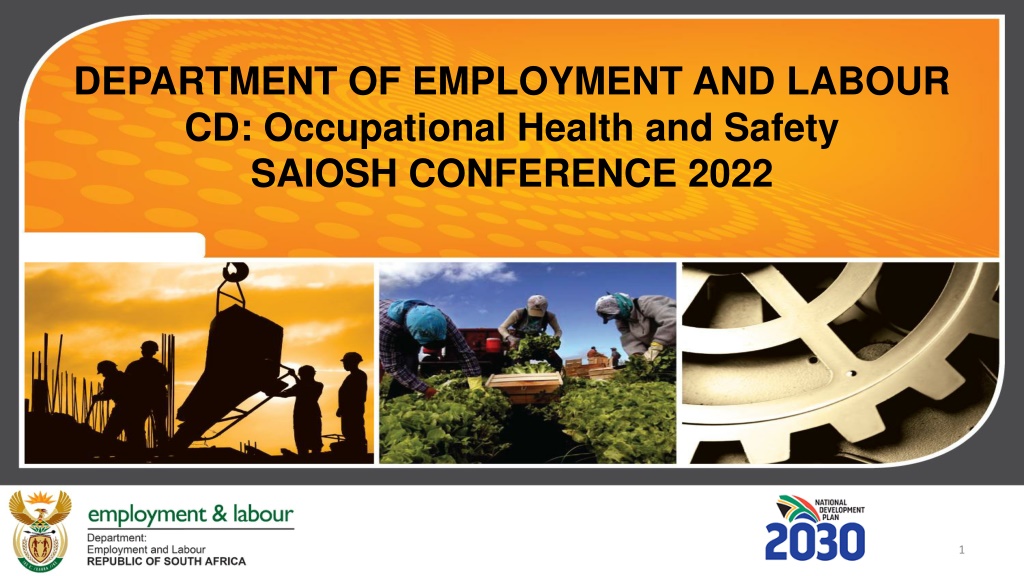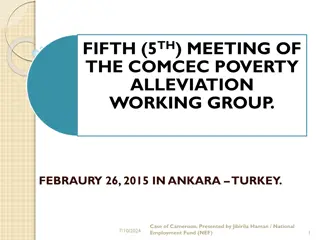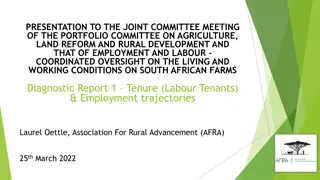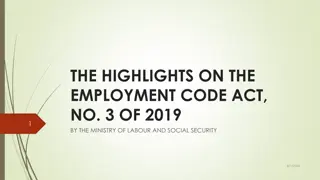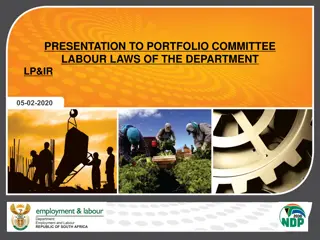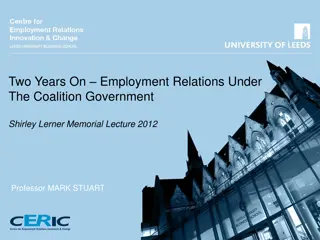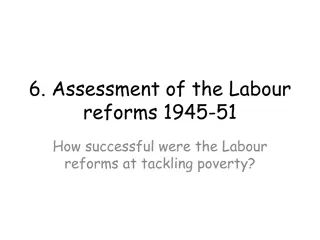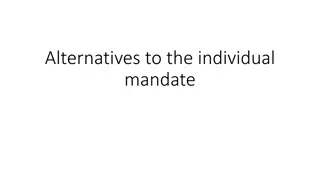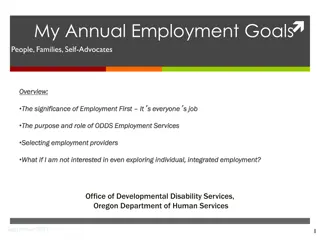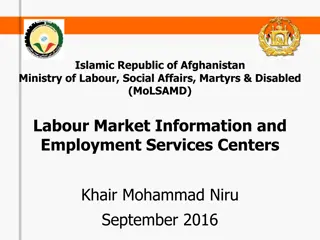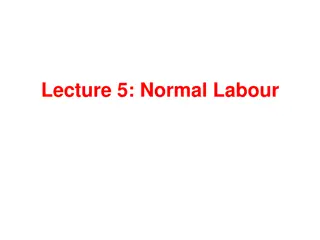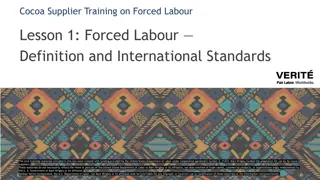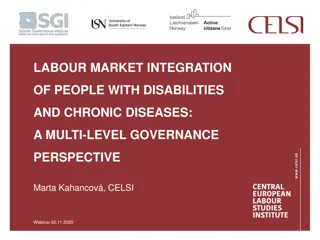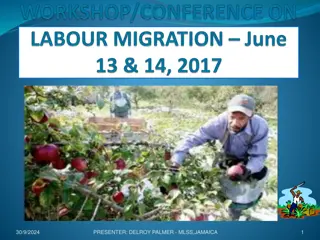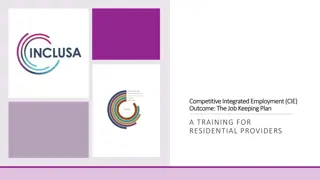Department of Employment and Labour: Vision, Mandate, and Objectives
The Department of Employment and Labour aims to regulate the labor market through policies focusing on economic efficiency, decent employment, labor standards, and social safety nets. The department's vision is to create a conducive labor market for investment, economic growth, employment, and decent work. Their mandate includes developing programs in consultation with social partners to ensure labor market flexibility while promoting occupational health and safety, eliminating workplace discrimination, and enhancing labor relations.
Uploaded on Sep 26, 2024 | 0 Views
Download Presentation

Please find below an Image/Link to download the presentation.
The content on the website is provided AS IS for your information and personal use only. It may not be sold, licensed, or shared on other websites without obtaining consent from the author. Download presentation by click this link. If you encounter any issues during the download, it is possible that the publisher has removed the file from their server.
E N D
Presentation Transcript
DEPARTMENT OF EMPLOYMENT AND LABOUR CD: Occupational Health and Safety SAIOSH CONFERENCE 2022 9/26/2024 1
THE PRESENTATION. 1. The Vision and the Mandate of the Department 2. Constitutional Mandate 3. Objectives of the IES Branch 4. Functions of the IES Branch 5. Occupational Health and Safety Amendment BILL. 6. The OSH management system in the organization 7. The status of compliance currently/ Megabits Inspections. 9/26/2024 2
THE VISION OF THE DEPARTMENT OF LABOUR - to strive for a labour market which is conducive to - investment, - economic growth, - employment creation and - decent work (without exclusion) 9/26/2024 3
THE MANDATE OF THE DEPARTMENT OF LABOUR is to regulate the labour market through policies and programmes developed in consultation with social partners aimed at: Improved economic efficiency and productivity, creation of decent employment, promoting labour standards and fundamental rights at work, providing adequate social safety nets to protect vulnerable workers, 9/26/2024 4
THE MANDATE OF THE DEPARTMENT OF LABOUR is to regulate the labour market through policies and programmes developed in consultation with social partners aimed at: sound labour relations, eliminating inequality and discrimination in the workplace, enhancing occupational health and safety awareness and compliance in the workplace, Giving value to social dialogue in the formulation of sound and responsive legislation and policies to attain labour market flexibility for competitiveness of enterprises which is balanced with the promotion of decent employment. 9/26/2024 5
CONSTITUTIONAL MANDATE. Environment 24. Everyone has the right (a) to an environment that is not harmful to their health or wellbeing; 6
OBJECTIVES OF THE IES BRANCH To promote good labour practices: including sound labour relations, improved conditions at work and minimum wages, fair labour practices and a healthy and safe working environment. We are enforcing the law to achieve these objectives. To provide information on our labour laws: The Department is the initiator and guardian of our labour laws. It has the responsibility to inform clients about the laws and where appropriate to educate them. However, the Department does not act as a legal advisor. To ensure compliance with our labour laws: We will be both reactive (i.e. when dealing with complaints and accidents) and pro-active (identifying areas of non-compliance and advise on corrective action) to ensure that our laws are complied with.
FUNCTIONS / ACTIVITIES OF THE Inspections and Enforcement Services ADVOCACY Individual (Employers, Organised Labour, Employees ) Conferences, workshops and Seminars INSPECTIONS Specialised Inspections DG Reviews in EEA. Entity Audit (Boiler Inspections) UI Auditors Pro-active (Blitz Inspections/ target Inspections) Re-active (Complaints/ Inquiries) INVESTIGATIONS Investigation of incidents at workplaces Informal investigations Formal Inquiries 1. 2. 3. 8
FUNCTIONS / ACTIVITIES OF THE Inspections and Enforcement Services 4. ENFORCEMENT Undertakings by Employers Compliance Orders Improvement Notices Contravention Notices Prohibition Notices Prosecution (Recommendation for prosecution Criminal/ Labour) 5. REGISTRATION OF ENTITIES Divers , First Aiders , Explosives Managers/ Magazines, Electricians, Government Certificates of Competencies, Major Hazard Installation facilities, Boilers, Lifts, Escalators and Passenger Conveyors etc. 9
BACKGROUND OF THE OHS LEGISLATION. OCCUPATIONAL HEALTH AND SAFETY IN SOUTH AFRICA The Factories Act, 1918 (Act no, 28 of 1918) was promulgated, which set a standard for South Africa s industry. The Factories Act was improved on and replaced by the Factories, Machinery and Building Work Act, 1941 (Act no. 22 of 1941). This Act placed duties and responsibilities on users of machinery, occupiers of factories as well as builders. 40 years later we saw the introduction of the Machinery and Occupational Safety Act, 1983 (Act no. 6 of 1983) 10 years later by the Occupational Health and Safety Act, 1993 (Act no. 85 of 1993). What was notable of this Act was the introduction of Occupational Health Occupational Health and Safety Amendment BILL no. 422 of the 14th April 2021 10
Occupational Health and Safety Amendment BILL no. 422 of the 14th April 2021 health and safety management system means, a co-ordinated, comprehensive set of interrelated or interacting elements to establish occupational health and safety policy and objectives in order to optimally manage health and safety; 11
Occupational Health and Safety Amendment BILL no. 422 of the 14th April 2021 "risk assessment' means, the process of evaluating the risks to [an employee] a person s health and safety from workplace hazards and is a systematic assessment of all aspects of work that considers: (a) a complete hazard identification; (b) identification of all who may be affected by the hazard; (c) how the person is affected; (d) the analysis and evaluation of the risks; and (e) prioritisation of risks; 12
Occupational Health and Safety Amendment BILL no. 422 of the 14th April 2021 7. Occupational Health and safety management system (1) The chief inspector may direct- (a) [any] an employer in writing; [and] or category of employers by notice in the gazette to develop and implement an occupational health and safety management system. (b) [any category of employers by notice in the Gazette, to prepare a written policy concerning the protection of the health and safety of his employees at work, including a description of his organization and the arrangements for carrying out and reviewing that policy]. 13
Occupational Health and Safety Amendment BILL no. 422 of the 14th April 2021 7. Occupational Health and safety management system (2) [Any direction] A directive under subsection (1) [shall] may be accompanied by guidelines concerning the contents of the [policy] occupational health and safety management system concerned. (3) [An employer shall prominently display a copy of the policy referred to in subsection (1), signed by the chief executive officer, in the workplace where his employees normally report for service]. 14
The OSH management system in the organization The employer should show commitment to OSH activities in the organization, and make appropriate arrangements for the establishment of an OSH management system. 9/26/2024 15
The OSH management system in the organization Occupational safety and health policy The employer, in consultation with workers and their representatives, should set out in writing an OSH policy, which should be specific to the organization and appropriate to its size and the nature of its 9/26/2024 activities. 16
The OSH management system in the organization Organizing The employer and senior management should allocate responsibility, accountability and authority for the development, implementation and performance of the OSH management system and the achievement of the relevant OSH objectives. 9/26/2024 17
The OSH management system in the organization System planning, development and implementation The purpose of planning should be to create an OSH management system that supports: (a) as the minimum, compliance with national laws and regulations; (b) the elements of the organization s OSH management system; and (c) continual improvement in OSH performance. 9/26/2024 18
The OSH management system in the organization Evaluation Performance monitoring and measurement Procedures to monitor, measure and record OSH performance on a regular basis should be developed, established and periodically reviewed. Responsibility, accountability and authority for monitoring at different levels in the management structure should be allocated 9/26/2024 19
The OSH management system in the organization Action for improvement Arrangements should be established and maintained for preventive and corrective action resulting from OSH management system performance monitoring and measurement, OSH management system audits and management reviews. 9/26/2024 20
Occupational Health and Safety Amendment BILL no. 422 of the 14th April 2021 37A Inspector s powers to recommend fines (1) An inspector may make a recommendation in writing to the specialist inspector that a fine be imposed on an employer in terms of section 37B if the employer contravenes, or fails to comply with any provision of this Act. (2) The inspector concerned must serve a copy of the recommendation on: (a) the employer; (b) the health and safety committee, or if there is no health and safety committee, to any health and safety representative responsible for the working place in question; and (c) the representative trade union, or if there is no representative trade union, to every registered trade union at the work place. (3) The employer may make written representations to the specialist inspector within 30 days of the recommendation. 21
Occupational Health and Safety Amendment BILL no. 422 of the 14th April 2021 37B. Specialist Inspector may impose a fine (1) The specialist inspector, after considering the recommendation and any representations made in accordance with section 37A, may- (a) disregard the recommendation; (b) impose a fine not exceeding the maximum amount mentioned in Schedule2; or (c) refer the matter to the prosecuting authority for a decision as to whether the employer should be charged with an offence. 37D. (2) Any person aggrieved by the imposition of a fine as contemplated by section 37B, may apply for a review to the Labour Court. 22
Occupational Health and Safety Amendment BILL no. 422 of the 14th April 2021 37B. Specialist Inspector may impose a fine (2) The Specialist Inspector must notify the employer, the health and safety committee, or if there is no health and safety committee, to any health and safety representative responsible for the working place in question; and the representative trade union, or if there is no representative trade union, to every registered trade union at the work place contemplated in section 37A (2), as the case may be, of any decision made in terms of subsection (1). (3) An employer must pay any fine imposed in terms of this section within 30 days of the imposition of the fine (4) If the employer fails to pay the fine within the specified period the Chief Inspector may apply to the Labour Court for the fine to be made an order of court. 23
Occupational Health and Safety Amendment BILL no. 422 of the 14th April 2021 SCHEDULE 2 Administrative fines Contravention of any of sections 7, 13, 17(1), (2), (5) & (6), 18(3), 19(1) & (7), 20(4), 21(1), 24(1) & (2), 25, 29(3), 30(2) &(6), 30(a); (b); (c) & (d), (3), (4) & (6), 34, 36, 37I No previous contravention R50 000 A previous contravention in respect of the same provisions R100 000 A previous contravention within the previous 12 months or two previous contraventions in respect of the same provision with three yearsR200 000 Three previous contraventions in respect of the same provision with three years R300 000 Four previous contraventions in respect of the same provision within three years R500 000 24
Occupational Health and Safety Amendment BILL no. 422 of the 14th April 2021 37F. Criminal liability (1) An employer, chief executive officer, manager, agent, user or employee commits an offence by contravening or failing to comply with a provision of this Act, thereby causing a person s (a) Injury; (b) Death; (c) Permanent disablement; or (d) Illness. (2) An employer, chief executive officer, manager, agent or employee commits an offence by performing or omitting to perform an act, if the act or omission falls within the scope of the authority or employment of the employer concerned. 25
9/26/2024 26
Decision making by Inspectors and Specialist Inspector "reasonably practicable" means practicable having regard to- the severity and scope of the hazard or risk concerned; the state of knowledge reasonably available concerning that hazard or risk and of any means of removing or mitigating that hazard or risk; the availability and suitability of means to remove or mitigate that hazard or risk; and the cost of removing or mitigating that hazard or risk in relation to the benefits deriving therefrom; 9/26/2024 27
Mega Blitz Inspection report 2. Introduction The rationale of the mega blitz inspections is to improve the compliance levels of employers by using high visibility and an advocacy through the use of national and provincial media platforms. The objectives of this mega blitz are: (a) Increased awareness (b) Heightened visibility (c) Improved compliance levels
Mega Blitz Inspection report 2. Introduction The rationale of the mega blitz inspections was to improve the compliance levels of employers by using high visibility and an inordinate amount of advocacy through the use of national and provincial media platforms. The objectives of this mega blitz are: (d) Improvement in the level of partnerships with various key stakeholders and role-players through conducting joint inspections in various areas of responsibility. (e) Improved interaction with vulnerable workers in the sectors that matter most as identified by the provinces. (f) To explore areas for cooperation among the different stakeholders.
Mega Blitz Inspection report 3. Inspections conducted provincially A total of 4 783 inspections conducted during the five provincial mega blitz inspections 87 369 756 761 2810 Eastern Cape Western Cape Kwa-Zulu Natal Limpopo Mpumalanga
Mega Blitz Inspection report 4. Provincial sector compliance A total of 4 783 inspections conducted during the five provincial mega blitz inspections Overall Inspections Conducted provincially 3000 2818 2500 2000 1407 1403 1500 1000 761 756 438 400 369 356 500 323 320 87 49 49 38 0 Eastern Cape Western Cape Kwa-Zulu Natal Limpopo Mpumalang Total Insspections Non-compliant Complied
Mega Blitz Inspection report 5. Aspects related to non-compliance A total of 4 783 inspections conducted during the five provincial mega blitz inspections % of compliant vs non-compliant 100% 90% 80% 42 44 51 53 70% 60% 87 50% 40% 30% 58 56 49 47 20% 10% 13 0% Eastern Cape Western Cape Kwa-Zulu Natal Limpopo Mpumalanga Compliant None-compliant
Mega Blitz Inspection report 6. Legal Instruments Served. Prohibition 1%19 Improvement 1%16 A total of 1 910 enforcement documents during the five provincial mega blitz inspections Compliance orders 47%899 Prohibition Contravention 976 51% Prohibition notices Improvement notices 16 Contravention notices 976 Compliance orders 19 Improvement Contravention Compliance orders 899
Mega Blitz Inspection report 7. Challenges In most instances, inspectors were well received, with a few exceptions. Employers allowed the Department to conduct inspections despite the challenging environment at times. Challenges experienced between the WC, EC and KZN were mostly different due to sector differences. Issues of undocumented foreigners were a challenge in Limpopo and Mpumalanga. 8. Conclusion The mega blitzes conducted thus far have been very successful in their outcome and further mega blitzes inspections will continue to be conducted. The direct involvement of the Provincial Chief Inspector and their teams has contributed to the overwhelming success of the project thus far.
THANK YOU. PHUMUDZO MAPHAHA
